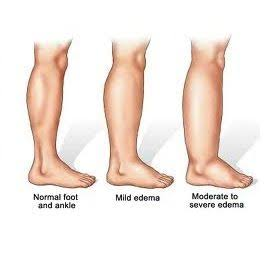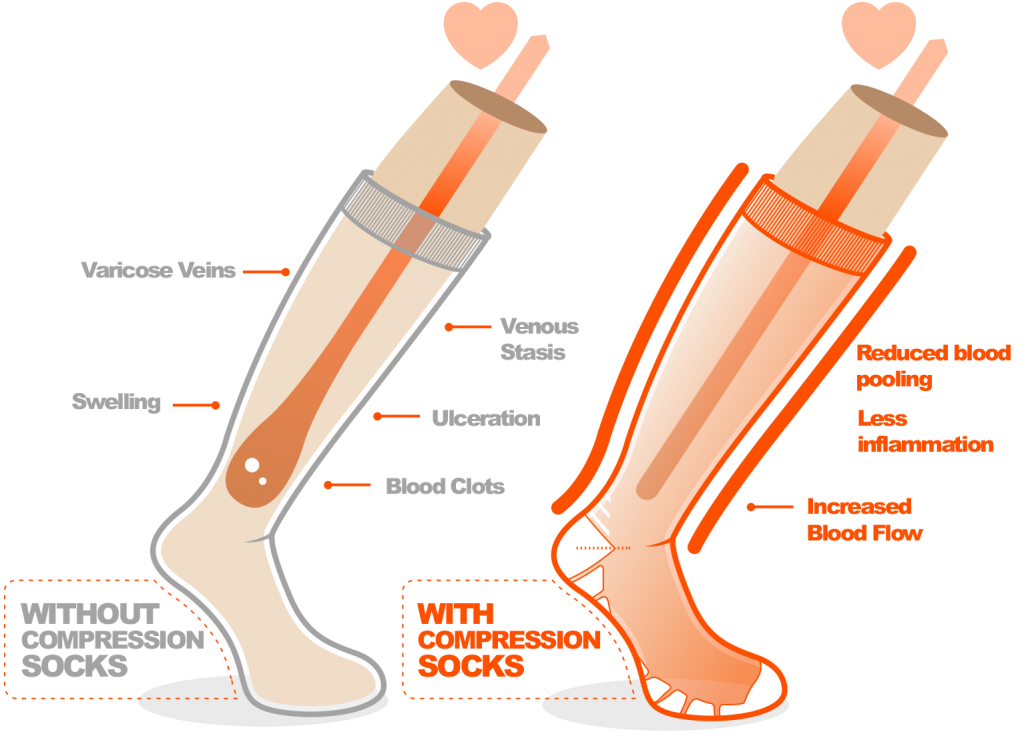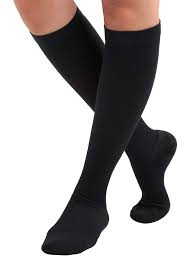- Put them on in the morning
- If you take them off, try to elevate your legs before putting them back on
- Take them off before bed
How Long to Wear Compression Socks to Stop Edema & Swelling
Benefits of Compression Socks:
• Stop Swelling (also known as Edema)
• Promote Increasing Circulation
• Stop Lipoedema
• Pull Fluids Up Your Leg
• Decrease Fluid Retention
• Increase Blood Circulation
• Prevent Blood Clots
• Improve Blood Flow
Doctors usually prescribe compression socks to be put on in the morning and worn all day.
Note: If you take them off, it’s best to elevate your legs if possible.
(Elevating your legs is another way to reduce swelling and prevent fluid build-up. Plus it keeps your legs from turning into giant sausages that don’t fit in the compression socks when you go to put them back on!)
Take them off before bed.
If you have edema, you should get it treated fast.
Check with your doctor, because edema can be a sign of an underlying medical condition.
Compression socks can help reduce edema, but only if you get a quality pair and wear them correctly.
Let’s talk about what edema is, why compression socks work, and how to wear them.
What is Edema?
Edema = Swelling
Edema is basically just another word for Swelling.

Simply put, edema is another term for swelling, which occurs when excess fluid gets trapped in body tissues.
This fluid may be the result of injuries, such as when swelling is caused by blunt force trauma. In other cases, swelling can occur because of pregnancy, allergic reactions, lack of movement, or poor blood circulation.
More serious causes of edema include severe illnesses, such as liver or kidney disease, restricted blood flow to the limbs, complications related to diabetes, varicose veins, deep vein blood clots, and hypoalbuminemia (albumin deficiency.)
Edema can be unsightly and uncomfortable in mild cases. When it is more severe, however, it can restrict movement and be incredibly painful. This can create a snowball effect because, when you decrease your movement, your swelling can increase even more.
How Compression Socks Treat Edema
Compression Socks directly push inward to stop swelling (also known as edema). Compression also helps with increasing circulation, which decreases stagnant blood and decreases swelling.

Besides using prescription drugs to treat symptoms and underlying causes of edema, doctors may also recommend the use of compression socks.
Compression socks generate pressure to decrease fluid retention in the body, especially in legs and feet. Some come in graduated compression, which means they apply the greatest amount of pressure at the ankles and lesser pressure upwards.
By increasing the pressure on the legs, compression socks encourage more efficient circulation. This means that the blood does not pool in the ankles and feet but instead returns to the heart in a timely manner. In a similar way, compression socks prevent other fluids from staying in the lower leg area.
Compression socks for edema can help relieve some of the pain caused by swelling almost immediately after you put them on. This means that you may be able to move around more easily, which can also help decrease swelling.
How long do I have to use Compression Socks?
1. Put on compression socks first thing in the morning (before the swelling begins)
2. Take off compression socks before you go to sleep at night.
Tip: You can take your compression socks off during the day for short rest periods if you want. If your legs swell up, just lie down with your legs elevated before putting the compression socks back on.

Compression socks can be worn for a short period to treat edema, however, it is advisable to consult with a doctor on whether or not to wear compression socks, what type would be most beneficial, and how long they should be worn for.
Essentially, compression socks can be worn daily with a doctor’s okay.
(Compression Socks don’t require a prescription. You can buy ComproGear Compression Socks on Amazon here. But we highly recommend talking to a doctor about the underlying cause of your swollen feet / edema. Don’t use compression socks to cover up a serious medical condition.)
Some people find compression socks uncomfortable at first because it is a tighter sock than they are used to wearing. If this is the case for you, start by wearing the sock for shorter stretches such as an hour or two. Then, work your way up to wearing them the whole day.
For the best results, put on your compression socks first thing in the morning. After lying flat all night, your legs will be less swollen, so it will be easier to get the socks on.
It is also best to take off your compression gear every night before bed as wearing them during sleep can restrict the blood circulation in the legs.
What are the side effects of compression stockings?
Some side effects may occur if a pair of compression socks that are too tight or too small are worn, as well as if they are worn for too long (i.e. all day, non-stop). Remove the socks immediately if any of the following occurs:
- Discomfort.
- Redness.
- Joint pain.
- Tingling feet.
- Allergic reactions or irritation (usually caused by the material).
Compression Levels Available
We recommend Compression Socks in the 20-30 mmHg compression range
Compression socks typically have four standard levels of compression, which are measured in ‘millimeters of mercury (mmHg)’. Choose your socks according to your needs, as the higher the compression level, the stronger the pressure applied.
15-20 mmHg (Over-the-Counter)
Low-pressure socks suitable for mild edema and aching legs or feet.
20-30 mmHg (Medical Grade Class 1) – Our Recommendation for Compression Socks
Can treat varicose veins and sports injuries; commonly used by seniors and pregnant women.
30-40 mmHg (Medical Grade Class 2) – High Compression, Usually Not Required
Designed to treat moderate to severe edema, deep vein thrombosis (DVT) and lymphedema. This compression level is only available with a prescription.
40-50 mmHg (Medical Grade Class 3) – Very High Pressure, Use Only Under Doctor Supervision
The strongest compression level available and should not be worn without consulting a medical professional; these are for very severe cases of lymphedema, venous stasis, or serious wounds.
As the wrong compression level can do more harm than good, it is always best to check with your doctor before choosing your compression level. It also helps that your doctor can diagnose the underlying cause of your swollen legs (edema).
We recommend using ComproGear Compression Socks in 20-30 mmHg Compression. You can find them on Amazon here.
Compression Sock Styles
Our most popular color of ComproGear Compression Socks is black
We only offer ComproGear Compression Socks in knee high length (this is the most appropriate length for most people)
Like regular socks, compression socks are available in a wide variety of shapes and sizes.
- Ankle Socks: The smallest compression socks go over the feet only. These are good for people with mild foot aches but no other leg ailments.
- Knee-High Socks: This is the most popular type of compression sock. It addresses the most common leg diseases but is also suitable for mild discomfort and athletics.
- Leg Sleeves: Leg sleeves are similar to a knee-high or thigh-high sock, but they do not cover the foot. They are especially popular with athletes or people in warm climates.
- Thigh-High Socks: These go over the knee and extend to the upper thigh. They are appropriate for people with severe varicose veins and edema whose problems extend above the knee.
- Pantyhose: Pantyhose style compression gear covers the foot, calf, thigh, and hip. These are prescribed for the most serious cases of vein disease and for bedridden patients.
The terms “compression socks” and “compression stockings” are interchangeable.
We suggest knee high compression socks in 20-30 mmHg compression.
You can get a pair from ComproGear here.
How do I Find the Right Compression Socks?
It is best to measure your legs and feet in the morning when they are the least swollen. If you need compression socks for medical reasons, ask a medical professional to measure you for proper sizing.
The right compression socks for you can be different to someone else.
One-type-fits-all does not apply to compression socks.
Look for sizing, type, and compression level. These factors vary from one person to another.
Those one-size-fits-all compression socks are a scam. They’re meant to help the producer keep stock levels down. They don’t actually work.
You wouldn’t buy “one size fits all” pants or shirts. And it’s even more important for compression socks, since having sizing off even a tiny amount will ruin the compression level. Too small and you have too much compression. Too large and you have too little compression.
Also too small of a compression sock could cut off circulation. This is, medically speaking, real bad.
Measurements matter: Before buying a compression sock, make sure to get the measurement of the length from your heel to your knee and the circumference around your calf. If your swelling goes above the knee and you have to buy thigh high compression socks, record the circumference of the widest part of your thigh as well.
The most important size for compression socks is the calf circumference.
For ComproGear Compression Socks, we offer a lifetime guarantee which includes sizing. More than 90% of our customer refunds are for incorrect sizing. We’re fine with that. Happy really. We want you to have the right size compression sock.
Remember that you will need at least two pairs of compression socks so that you have one to wear while you wash the first.
We recommend ComproGear Compression Socks.
How to Wear Compression Socks for Edema
The best socks for swollen feet (edema) are the socks that you actually wear. So get a pair you like that fits right.
Here’s how to put on your compression socks:
- Sit in a straight-backed chair for support.
- Ensure your legs and feet are clean and dry. Dry skin allows the socks to pass smoothly over your legs. Do not put on lotion beforehand.
- Roll up the stockings and gently place your toes in it. Continue to pull the sock on until it completely covers your foot and toes, but keep it rolled as much as possible.
- Carefully roll the sock back up, making sure you don’t pull too hard. Excessive tugging can cause the fabric to run or tear.
- Smooth out any wrinkles and bunches along the seam to ensure that the seam is straight.
- Repeat for the other leg.
If you have limited mobility or extreme swelling that makes putting on the compression socks difficult, consider investing in a donning tool.
This is a simple device that helps extend your reach and put on your compression socks correctly.
The best time to put on compression socks is in the morning before your legs are too swollen to get them on. Edema / Swelling is usually the lowest in the morning since your legs have been elevated all night.
Additional tips for wearing compression socks
- Replace a pair of compression socks every few months. Do not wear any socks with holes, frays, etc.
(Note: ComproGear Compression Socks have a lifetime guarantee. If they ever get worn out just contact us and we’ll send you a new pair free of charge.) - Buy at least two pairs of compression socks. As one pair is being washed, there will be another pair you can wear.
- Wash compression socks with cool or lukewarm water. No bleach or harsh chemicals.
- Always air dry. A hot dryer will destroy compression socks real quick.
Where to Buy Compression Socks
Check out ComproGear Compression Socks. They’re designed with Medical-Grade 20-30 mmHg Compression in Knee High Length to stop Edema (swelling) fast! Most customers find they stop painful swollen feet and calves instantly. Plus they’re made with moisture wicking fabric to keep going all day long.
Compression socks can help you maintain or improve your leg health, especially if you suffer from edema or other circulatory issues.
But compression socks only work if you get a good quality pair.
Aren’t they all the same? Isn’t one brand the same as the next?
No.
When we started ComproGear Compression Socks, we got custom samples from 17 different manufacturing facilities.
We thought they would all be great compression socks…
…we were so wrong!
16 of the compression socks were junk.
They were so thin we laughed when seeing them. Were these really compression socks?
You could see through them like shear pantyhose.
They had the quality level of toilet paper in a public bathroom. (aka terrible garbage)
Then, to add insult to injury, they had these hilarious sizes. Small/Medium and Large/XL. Really?
We sent over a specification sheet for Small, Medium, Large, X-Large, 2X-Large, 3X-Large, 4X-Large, 5X-Large, and 6X-Large. They sent back Small/Medium and Large/X-Large.
What junk. No thanks.
Eventually we found the 1 supplier that sent quality compression socks. They were sized to our specifications, made with the correct material, and had proper compression.
Plus they, get this, they actually stopped edema and swollen legs.
Where did all those other suppliers go?
They’re all over Amazon and similar sites. When you see a 5 pack of compression socks for $8.99 now you know. They’re expensive trash can liners.
And if you see a compression sock size like “Small/Medium”, 🏃 run the other direction!
That’s why we can’t really recommend any other brands of compression socks. There are too many junk quality ones to count.
That’s why we also offer a lifetime guarantee. You can get a refund of ComproGear Compression Socks at any time for any reason.
Most, and I mean 90% or more, of our refunds are for incorrect sizing. We actually love seeing these sizing refunds. It means someone is upgrading to the correct size at no extra cost to them. It’s one less person getting scammed by the “one size fits all” compression sock marketeers.
What do you have to lose (except your painful swelling)? Click the button below to take a look at our selection on Amazon:
This page last updated December 10, 2022
